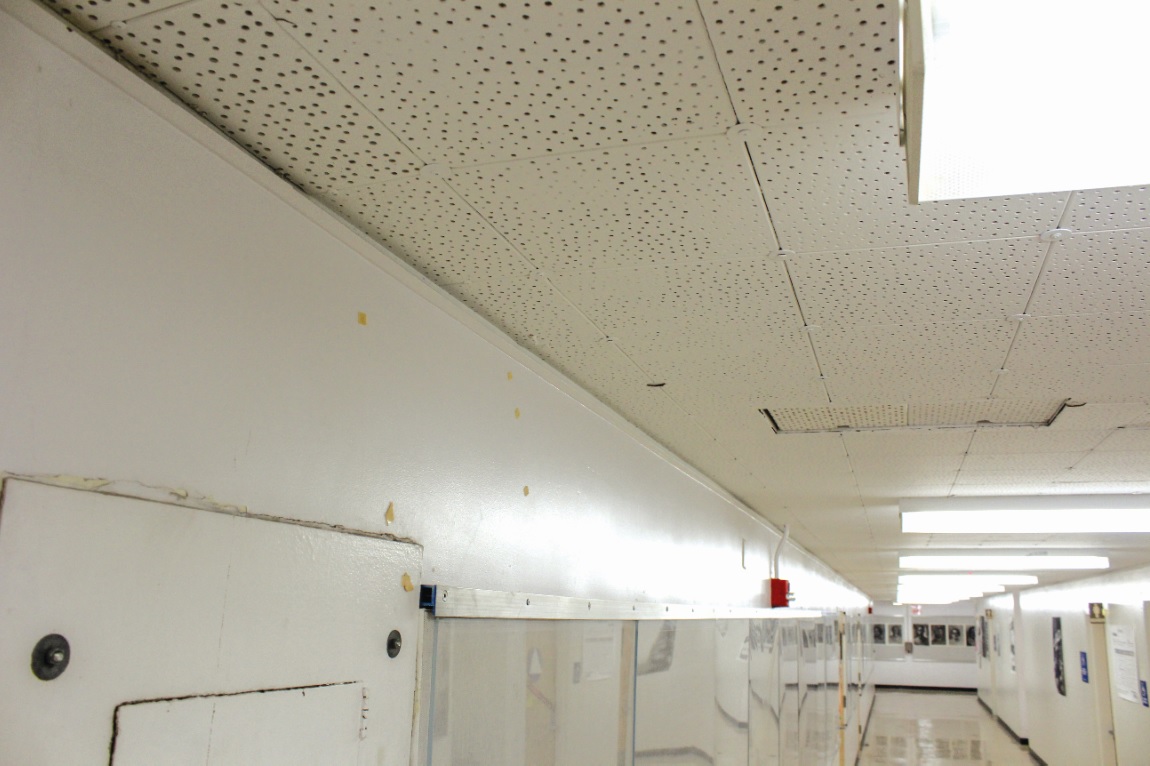Jeff Atherton, a foundation art professor, can recall two semesters ago when a dead mouse fell from the ceiling of his color theory class in Fine Arts 4 room 222.
“I think that the mouse had eaten some of the poison bait that has been placed around the building,” Atherton said via email. “After ingesting the poison, the mouse found its way into my room and got up on the curtain, or the lockers that are in the back of the room. I happened to be looking in that direction when the mouse dropped … to the ground.”
To date, Atherton has not had another issue with mice. However, stories like this are common in the Fine Arts 4 building. From falling ceiling tiles to leaking roofs and walls, the consensus among many in the Long Beach State School of Art is that the building is in need of renovations.
“No doubt, the building needs repair,” said Aubry Mintz, the director of the School of Art who works in FA-4 and has witnessed first hand many of the issues the aging building faces.
According to Michael Gardner, capital project manager of Facilities Management, FA-4 was built in 1962 and has been due for renovations since the ‘90s.
“I believe that the contractor was going to do Fine Arts 1, 2, 3 and 4,” Gardner said. “I believe that he went bankrupt in the middle of the project, and so the project basically got screwed up because of that.”
For students like third-year studio art major Madeline Taylor, air conditioning is one of the biggest problems, which is only present through portable air conditioning units recently issued by facilities management.
“It gets really hot in there all the time,” Taylor said. “It’s really terrible. They should put [a ventilation system] in there because like half the time, you feel like you’re going to pass out if it gets too hot in there.”
Professors like Marian Stewart, who teaches foundation drawing, are concerned with the way the rooms function. Stewart believes that the rooms need new lights because students who deal with value of color cannot properly see the colors they are looking at.
“The facilities are not functioning well,” Stewart said. “The lighting doesn’t work well. I know students are concerned about ceilings, that to me is the least of my problems. I’m much more concerned about just having a room.”
Stewart is also worried about lack of work space for art students to finish their assignments, as most need specialized rooms or equipment to finish projects or homework.
“It’s just a lack of funding, and it impacts instruction because we just don’t have the type of equipment we need or the space we need,” Stewart said.
All schools in the California State University system propose to the state what their campus needs funding for and then they decide how much funding is given to each school. Then Academic Affairs decides with the dean of the College of the Arts what projects need priority.
“The State has definitely slowed down in funding academic building renovations, and they did recently fund the soon-to-be-completed Student Success Center,” Gardner said via email.
According to Gardner, Facilities Management has a schedule defined by Academic Affairs to renovate buildings based on priority that they, along with administration, feel is necessary.
Next on the Facilities Management’s schedule is a project that will be to turn Peterson Hall 1 into a College of Health and Human Services building. FA-4 is after that. Gardner estimates that renovations for FA-4 will happen in six years and will include completely gutting the building.
“So it would be everything from windows to relocating walls to make the rooms function better for whatever the current needs are,” Gardner said.
For now, Facilities Management does what they can with the funding provided. This includes making sure that minimum safety codes are met.
Issues including the ceiling tiles and air conditioning have been fixed through temporary methods, such as portable air conditioning units, and screws and washers that have been placed in the ceiling tiles to prevent them from falling on students.
“There’s still an amount [of tiles] that [are] falling,” Mintz said. “And now it’s not the tiles that are falling, but the screws that are falling. It’s a little piecemeal, but it’s a step forward. At least it was a band-aid step forward.”




